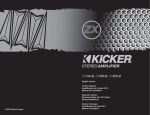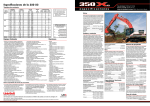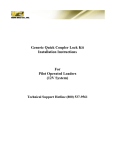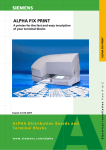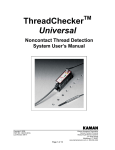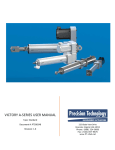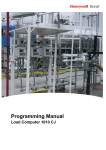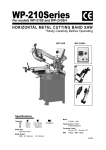Download Multilock install manual
Transcript
Quick Coupler Lock Kit Installation Instructions For John Deere 250G Hitachi ZX250-5 DQ7-JD0041-NCB TABLE OF CONTENTS GENERAL SAFETY GUIDELINES FOR INSTALLING THE KIT ..................................3 BEFORE STARTING THE KIT INSTALLATION .............................................................4 JIC 37° FLARE CONNECTIONS .........................................................................................5 O-RING FACE SEAL CONNECTIONS ..............................................................................6 STANDARD TIGHTENING TORQUE................................................................................7 PRECAUTIONS BEFORE WELDING ................................................................................8 SYSTEM OVERVIEW..........................................................................................................9 View From Above Drawing .............................................................................................10 STICK AND BOOM HOSES ..............................................................................................11 Hoses On Stick Drawing ..................................................................................................13 Hoses On Boom Drawing.................................................................................................14 CONTROL VALVE.............................................................................................................15 General Overview Drawing..............................................................................................18 Hydraulic Schematic and Electrical Wiring Diagram......................................................19 FINISH AND TEST.............................................................................................................20 BILL OF MATERIALS .......................................................................................................21 APPENDIX A ......................................................................................................................23 APPENDIX B.......................................................................................................................25 CUSTOMER FEEDBACK FORM......................................................................................26 TOTAL NUMBER OF PAGES 26 Page 2 GENERAL SAFETY GUIDELINES FOR INSTALLING THE KIT • Read the instruction manual thoroughly to familiarize yourself with the kit before installing it. Deviating from the drawings and/or instructions in this manual may result in increased installation time and/or damage to hydraulic kit, machine or attachment. • Follow proper procedures as specified in the ‘Service Manual’ for your machine. In case of discrepancies in guidelines between the ‘Service Manual’ and our kit instructions, the manufacturer safety instructions take precedence, especially regarding the welding instructions. • Be careful while handling hot parts on machines that have just been stopped. The hydraulic fluid in the lines, tubes and components are very hot and could cause severe skin burns. It is advisable to allow hydraulic oil to cool down before removing any lines, fittings, tubes or plugs on machines. • It is very important to relieve the hydraulic tank pressure before loosening any connections or hoses. Follow proper procedures as specified in the ‘Service Manual’ for your machine. • Lower the bucket or any attachment to the ground. • Check and tighten all fittings and hoses before activating the circuit. • Use a piece of cardboard to check for oil leaks in the circuit, in order to prevent contact with high-pressure oil. • Kit installation procedures outlined in this instruction manual have been arranged to keep the hydraulic oil spills to a minimum. However, during kit installation, oil spills are unavoidable and should be contained using rags, absorbent towels or containers/buckets. Dispose of all waste oils, fluids, lubricants and other hazardous waste properly. If there is an oil spill on the floor, use liberal amounts of “oil dry” to avoid slippery conditions. • Use safety protection such as hardhat; working gloves, safety shoes and safety glasses as needed to do the job. Page 3 BEFORE STARTING THE KIT INSTALLATION • Check to make sure this installation kit is correct for your excavator and/or attachment. Check the excavator information against kit description. If there are any concerns or discrepancies please contact the manufacturer immediately. • Open crates/boxes to take inventory of parts. Compare them with the Bill of Materials to make sure no parts are missing. Please note that to reduce installation time, some components/valves/parts are pre-assembled before shipping. In case of any discrepancies, contact the manufacturer immediately. • Make sure there are enough rags, absorbent towels and/or containers available. • Steel brackets/mounts are protected from corrosion using powder coat or primer. It may be necessary to paint these to match the excavator color after completing installation and checking all hoses for binding/pinching. Ensure there is enough factory paint available to do so. • Read instructions manual to familiarize yourself with the installation kit. • For the purpose of kit installation, it is a safe practice to have the machine on a level surface. • Shut off engine. If the machine has just completed work then allow sufficient time for cooling before opening any lines. • Disconnect battery. Remove the negative (ground) terminal connection. • Release pressure from the hydraulic tank. • Refer to the sheets on the following pages for the proper torque specifications. These torque specs must be followed to prevent damage. Page 4 JIC 37o FLARE CONNECTIONS The 37° JIC (Joint Industrial Council) flare is a reliable, straight thread, flare design that is used world-wide. It is popular in many applications and environments because it is compact and easy to assemble. Since it is a metal-tometal seal it can be reliably connected and reconnected multiple times. The assembly may or may not include a sleeve. Figure 1. Female Swivel without Sleeve Sleeve Figure 2. Female Swivel with Sleeve Dash Size 2 Torque Value lb-in N-m F.F.F.T -4 130-150 15-17 2 -6 235-265 27-30 1-1/4 -8 525-575 59-65 1 -12 950-1050 107-119 1 -16 1400-1500 158-170 1 -20 1900-2100 215-237 1 -24 2250-2550 254-288 1 1 Note : 1. The Flats From Finger Tight (F.F.F.T.) method counts the number of hex flats past the finger tightened position. a. Visually inspect the threads to make sure they are clean. b. Hand tighten the female swivel nut onto the male thread. c. Make alignment marks on the nut and fitting. d. Proceed to tighten to F.F.F.T. value. 2. These torque values are given for components without lubrication. Do not use oil on the threads before tightening. Compiled on: 02/14/05 Page 5 O-RING FACE SEAL CONNECTIONS The O-ring Face Seal connection is one of the most reliable, leak-free connections available on the market today for mobile hydraulic applications. The use of an elastomeric seal (o-ring), as apposed to a metal-to-metal connection, has many advantages. It is very resistant to vibrations or pulsations in the system. The connection can be assembled and dismantled many times without compromising the integrity of the connection. It is important to note that because the connection is dependent on the o-ring, some simple precautions must be taken. The o-ring and fitting must be visually inspected before the connection is made. If the o-ring or o-ring groove is nicked, bent, warped, cut, or otherwise damaged, it must be replaced immediately. Use a minimal amount of grease to install the o-ring into the groove paying careful attention that it is seated properly. Take care not to get grease on threads. The o-ring will be permanently damaged if it is not seated properly and the connection will leak. Nominal Size Dash Size 1/4" 3/8" 1/2" 5/8" 3/4" 1" 1-1/4" 1-1/2" -4 -6 -8 -10 -12 -16 -20 -24 Assembly Torque ft.-lb. N-m 18 25 30 40 40 55 60 80 85 115 110 150 140 190 180 245 F.F.W.R. 1 1/2 to 3/4 1/2 to 3/4 1/2 to 3/4 1/2 to 3/4 1/3 to 1/2 1/3 to 1/2 1/3 to 1/2 1/3 to 1/2 Table 1. ORFS Torque Specifications Note 1. If a Torque Wrench is not available, an alternate method of assembly is the Flats From Wrench Resistance (F.F.W.R.). Tighten the nut onto the fitting body until light wrench resistance is reached. Tighten further to the appropriate F.F.W.R. value shown in Table 1. Using a Torque Wrench is the preferred and suggested method and should be used whenever possible. Page 6 STANDARD TIGHTENING TORQUE The following Table gives the standard tightening torques of bolts. This applies to mounts, tube clamps, split flange clamps, and any other bolts provided with this kit. It is important to follow this chart when installing bolts and nuts. Failure to do so could result in premature failure, damage to components, or even serious injury. NOTE: Nm (Newton meter): 1Nm = 0.102 kgm = 0.737 lb.ft. Standard Tightening Torque Of Metric Bolts Bolt O.D. x Pitch (mm) M6x1 M8x1.25 M10x1.5 M12x1.75 M14x2 M16x2 M18x2.5 Metric Class 10.9 kgm Nm lb.ft. 1.3 +/- 0.15 3.2 +/- 0.3 6.5 +/- 0.6 11 +/- 1 17.5 +/- 2 27 +/- 3 37 +/- 4 13.5 +/- 1.5 32.2 +/- 3.5 63 +/- 6.5 108 +/- 11 172 +/- 18 268 +/- 29 366 +/- 36 10 +/- 1 24 +/- 2.6 47 +/- 4.8 80 +/- 8 127 +/- 13 198 +/- 22 270 +/- 26 Page 7 PRECAUTIONS BEFORE WELDING Note: These techniques are a general guideline only. If the excavator manufacturer has published welding guidelines, use them instead. • Turn off the engine and disconnect the battery. • Release the pressure from the hydraulic tank. • Protect all areas in, on and around the machine with a flame resistant covering during grinding and welding operations. Use proper solvents to clean parts for welding. Always clean parts in a well-ventilated area. Cover the cylinder rods and glass for protection against welding spatter. Protect any wiring harnesses in the vicinity. • Clean welding areas of any combustible materials like dried leaves, hydraulic oil etc. • Clamp the ground cable from the welder, directly to the component that will be welded. Place the clamp as close as possible to the weld. Make sure the electrical path from the ground cable to the component does not go through a bearing. Page 8 SYSTEM OVERVIEW This hydraulic coupler lock kit allows switching between different work tools (Buckets etc.) with the flip of a switch. An electrical control box actuates the coupler lock valve that directs pressurized oil to the coupler cylinder for locking or unlocking it. The coupler cylinder is in the LOCK position by default. The coupler (hydraulic pin grabber) unlocks and releases the work tool only when the control box ‘Control/Confirm’ button is activated and the pressure in the bucket curl-in line goes over 280 bar (4000 PSI). This safety feature in the hydraulic kit prevents accidental release of the work tool. In addition to the safety features in the hydraulic circuit, there is a load holding check valve installed on the coupler cylinder to prevent it from unlocking. Make sure the system in the LOCK position during machine operation. This will prevent accidental release of the work tool. After the coupler (hydraulic pin grabber) unlocks/unlatches, release the work tool before moving the machine. It is necessary to activate the bucket function to build up pressure for LOCKING and UNLOCKING the work tool. ¾ Lock: Grab the work tool (Bucket or any attachment) with the coupler. Follow the DROMONE instruction manual to lock the work tool in place by activating the bucket curl-in function with the control lever in the cab. Allow the circuit to complete its stroke i.e. till oil flows over relief. With the control lever in place, make sure the power button on the control box is OFF. Read the operator’s manual for more details on locking and unlocking the coupler. ¾ Un-Lock: Position the work tool (bucket or attachment) close to the ground for releasing. Follow the DROMONE instruction manual and actuate the control lever in the cab to activate the bucket curl-in function and allow the bucket cylinder to complete its stroke i.e. till oil flows over relief. With the control lever in place, activate the system by pressing the power button on the electric control box, and pressing the RED Control/Confirm button within 5 seconds. Release the work tool at this time. ¾ NOTE: After one minute the unit will return to it’s idle state, unless the ‘Control/Confirm’ button is pressed again within the last five seconds, when the audible alarm and visual indicator will return to intermittent mode to indicate the approaching end of action time. If the control button is not pressed within five seconds of the power button being pressed the unit will return to idle. ¾ Note: Refer to the operator’s manual for more details on control box operation. Page 9 Page 10 STICK AND BOOM HOSES • Install adapters [8 & 9] to the coupler lock cylinder ports. Connect the ¼” JIC end of hoses [100] to the fittings [8 & 9] and the 3/8” JIC end of the hoses [100] to the live swivels on the junction block assembly [4]. The junction block assembly [4] is located close to the end of the stick. • Curl the bucket in as far as possible, and let this suggest the mounting location of the junction block [4]. • Leave approximately 2-1/2” of slack in the hoses [100] to allow for cylinder movement while locking and unlocking. • Next, move the bucket to its fully dump position to ensure that the hoses [100] don’t bind or pinch. • This would be a good time to cycle the bucket throughout its range of motion to ensure that bucket cylinder nor the linkages come in contact with the junction block. • Tack-weld the block mount [5] in place. Bolt the junction block assembly [4] to the mount [5] using the hardware supplied in the kit. This block will be finish welded after completing kit installation and testing the circuit. Page 11 • Loosely affix the clamp assemblies [3] to the hoses using the drawing as a guideline. The hoses are routed together and can be routed on either side of the stick / boom. The drawing is for illustration purpose only. • Route the hoses over the stick and the boom as shown in the drawings. The hoses should preferably follow existing tubes and hoses. Hold the hoses in place and mark the location of the clamp [3] bases on the stick and boom. The hoses are joined together with male-female hose ends. Use nylon abrasion guard [12] around the hoses [101] running between the stick and the boom. (Hoses are identified on the Bill of Materials, and are marked with tags.) • Tack-weld the clamp bases in place. You will finish weld the clamps later. A note of caution: Do not finish weld the clamps with the hoses installed in them. Welding heat will damage the hoses. • Install hoses and check for correct alignment and routing. Operate the excavator and observe hose movement throughout the whole range of motion of the stick and the boom. There must be no binding or strain in any of the hoses. • When you are sure that the routing is correct, remove the hoses and finish weld the clamp bases. Reinstall the hoses. • Secure the hoses to existing tubes, brackets or hoses using nylon ties [18] where there is no space for clamp [3] installation. Page 12 Page 13 Dwg No: DQ7-JD0041 Hoses on Stick Connect hoses to coupler ports using adapters [8 & 9]. See 'General Overview' for details Detail A Hose Clamp [3] 1/4" 1/4" Remove inserts during welding and cooling! B 100 OEM A Not Drawn to Scale A 1/2" 1/2" Date: 08/27/12 101 5 Drawing By: AK Approved By: BMB This is the property of Hydraulic kit manufacture and shall not be altered, copied, used for manufacturing or duplicated by any other person or company without our written permission. To Coupler To Valve [1] Detail B 6 Port Block Assembly 4 Remove assembly during welding and cooling! Use Abrasion Guard [12] on exposed length of Hose. Secure with Wire Ties [18]. Page 14 Dwg No: DQ7-JD0041 Hoses on Boom 101 A Detail C C OEM Use Abrasion Guard [12] on exposed length of Hose. Secure with Wire Ties [18]. 101 103 Not Drawn to Scale A Date: 08/27/13 102 102 1/4" 1/4" Drawing By: AK Approved By: BMB This is the property of Hydraulic kit manufacture and shall not be altered, copied, used for manufacturing or duplicated by any other person or company without our written permission. Detail A Hose Clamp [3] C Remove inserts during welding and cooling! A CONTROL VALVE • Install the coupler lock valve [1] to the existing machine frame using valve mount [2]. • Determine the pump that delivers flow for the bucket function. On this machine this will be the front pump. • Remove the gauge coupling or the plug in the test port of the pump delivering oil to the bucket function and install the adapter [11]. Coupler Lock Valve [1] and Valve Mount [2]. FRONT Figure 1: Pump Compartment Pump Test Port • Install orifice adapter [99] to the fitting [11] at the pump test port. This adapter [99] will help reduce pressure spikes in the coupler lock system. • Connect 90° end of hose [104] to the adapters at the test port and route the other end to the ‘P’ port on the coupler lock valve [1]. FRONT Figure 2. Main Pumps Page 15 • Locate an existing plugged BSPP o-ring 06 (3/8”) port on the tank. See Figure 3 for details. Remove the plug and install adapter [10]. Connect one end of hose [107] to the adapter [10] route other end of hose [107] to the ‘T’ port on the coupler lock valve [1]. Use 90° swivel elbow [19] for proper hose routing if necessary. • Alternately there will be an existing plugged BSPP o-ring 06 (3/8”) port on the main return line behind the main control valve. See Figure 3 for details. Alternate Return Port Plugged Return Port Figure 3. Return Port Page 16 • The main supply line hoses from the service valves connect to tubes at the base of the boom. Locate the tube feeding the base end of the bucket cylinder (that which curls the bucket in). Remove the bucket circuit hose at the tube and insert tee [6]. Reinstall the existing hose to one end of the tee. Connect the 90° end of hose [105] to the ¼” adapter and route the other end to the ‘X’ port on the coupler lock valve [1]. Install tee assembly [6] here Figure 4. Tubes At Base Of Boom • Connect female ends of hoses [102] to the adapters at ‘A’ and ‘B’ ports of the coupler lock valve [1] and route the male ends towards the base of the boom. Hoses on the boom [103 and 101] will be joined together using male-female hose ends. • After all the hoses are connected it will be easy to determine the best/final mounting location for the coupler lock valve [1]. Relocate the coupler valve [1], if necessary, to route the hoses properly. There shouldn’t be any binding or strain in any of the hoses. • Mark the location of the mounting plate [2] and tack weld the plate in place. Finish weld only after removing the valve [1] otherwise welding heat will damage the valve seals. Reconnect all hoses and tighten. Page 17 Page 18 Page 19 FINISH AND TEST • Before starting this section, position the machine in the oil level check position as suggested by the excavator manufacturer. Check the oil level sight gauge on the hydraulic tank to ensure that the machine has enough hydraulic oil. Add hydraulic oil (use only excavator manufacturer recommended grade) if necessary. • Check again for proper hose movement and routing, then tighten all clamps, hoses and fittings. • Paint brackets and clamps to match the excavator. • Make sure the hoses [100] are connected to the coupler lock cylinder. • Run the machine at idle or at a low engine rpm setting, to supply a low volume of oil through the circuit and also, to keep the noise levels low. Activate the circuit and check for any leaks. Be ready to shut down machine immediately in case of leaks. When shutting down the machine, it is important to turn the engine rpm dial/setting to idle and shift the pilot safety lock lever to the “lock” position. Tighten fittings and hoses as necessary. • Clear all personnel from the area and all obstacles in the path of the machine. Operate the machine only when seated in the host machine. Keep the coupler close to the ground. • Activate the lock and unlock circuits several times to ensure that the system locks and unlocks with ease. Follow the instruction booklet/manual supplied with the coupler attachment for using different work tools. • It is advisable to join the two sides of the circuit together at the end of the stick and activate the ‘LOCK’ and ‘UNLOCK’ circuits for a couple of minutes to flush the system off any contaminants introduced during kit installation. • In order to reduce the risk of serious injury, it is advised to follow any and all safety procedures as specified in the coupler operation and safety manual. Page 20 COUPLER LOCK KIT BOM NUMBER :DQ7-JD0041-NCB DESCRIPTION :Dromone Coupler Lock Kit REV: Item # Part No. / Description Qty. 0001 Z-3696 / Coupler Lock Valve 24V 1 0002 M-6077 / Y1 M10x40 4170 Mount 1 0003 Z-4883 / Twin Hose Clamp 7 0004 Z-3699 / Junction Block Assembly 1 0005 M-0010-M / B01-Mount 1 0006 A-0004 / Z-2061-DT-SAE BKT Tee 1 0008 Z-1699 / Straight Adapter 1 0009 Z-1700 / Straight Adapter 1 0010 Z-1159 / Adapter 1 !! W/ Retaining Ring 0011 Z-1158 / Adapter 1 !! W/ Retaining Ring 0012 Z-2360 / Abrasion Guard #12 8 FEET 0014 E-0051 / W003 BB15-2BA05-2AA05 WH 1 0015 E-0052-63 / W001 2AB63-2AH WH 1 0018 Z-1152 / Wire Tie (Large) 0019 Z-1729 / 90 degree swivel elbow !! Refer to Appendix A 20 1 Page 21 COUPLER LOCK KIT BOM NUMBER :DQ7-JD0041-NCB DESCRIPTION :Dromone Coupler Lock Kit REV: Item # Part No. / Description 0099 Z-3067 / 1.5mm Orifice Connector 1 0100 H-0344 / 206x800SPx00Jx00J06 Hose 2 0101 H-1812 / 206x4200 Hose 2 0102 H-3553 / 206x3000x00Jx00E Hose 2 0103 H-3661 / 206x6300x00Jx00E Hose 2 0104 H-3091 / 206x800x00J06x90J Hose 1 0105 H-0943 / 206x2500x00Jx90J Hose 1 0107 H-1846 / 206x1200x00Jx00J Hose 1 0200 Z-5026 / Shipping Crate/No Runners 1 0201 INSTALLATION INSTRUCTIONS 1 !! Refer to Appendix A Qty. Page 22 Page 23 Page 24 APPENDIX B – DEUTSCH CONNECTION DETAILS • This section will describe the proper techniques used to install and repair the Deutsch connectors used in the hydraulic kit. • Removal and installation of the pins once the crimp has been made only requires the use of a flat head screwdriver (size dependent on connector size) and a pair of needle nose pliers. NOTE: The receptacle is shown. Use the same procedure for the plug. Contact Insertion 1. Hold the crimped contact approximately 1” (25.4mm) behind the contact barrel 2. Hold the connector with the rear grommet facing you. 3. Push the contact straight into the connector grommet until a click is felt. A slight tug will confirm a proper fit. 4. Once all contact are in place, insert the orange wedge (lock) with the arrow pointing toward the exterior locking mechanism. The orange wedge will snap into place. Rectangular wedges are not oriented. They may go in either way. Contact Removal 1. Remove the orange wedge using needle nose pliers or a hook shaped wire. Pull the wedge straight out. 2. Remove the contacts by gently pulling the wire backwards, while also releasing the locking finger. 3. Hold the rear seal in place so it does not pull out when removing the contact. Page 25 Reference # : 244984 Customer Feed Back Form At DROMONE we continually strive to provide the highest quality product. We feel there is no better opinion than that of the customer. This is why we ask that you take a few minutes to complete the form below and fax it back to us at 770-692-6978. Thank you for your time and effort in helping us provide the highest quality product possible. Purchaser/User Kit Number: Name Address DQCL- Base Machine Make Model Serial Number Phone Fax Installation Time (hours) Customer Feedback Did all components and/or parts fit well? YES Comments: NO YES NO Comments: Was the installation easy/simple? YES Comments: Were any modifications necessary? YES Were the instructions clear and concise? YES Were the drawings clear and concise? YES Did the kit fit well overall? NO Comments: NO Comments: NO Comments: NO Do you have any Comments: suggestions to improve the installation of this kit? Rev. 072103 Page 26


























